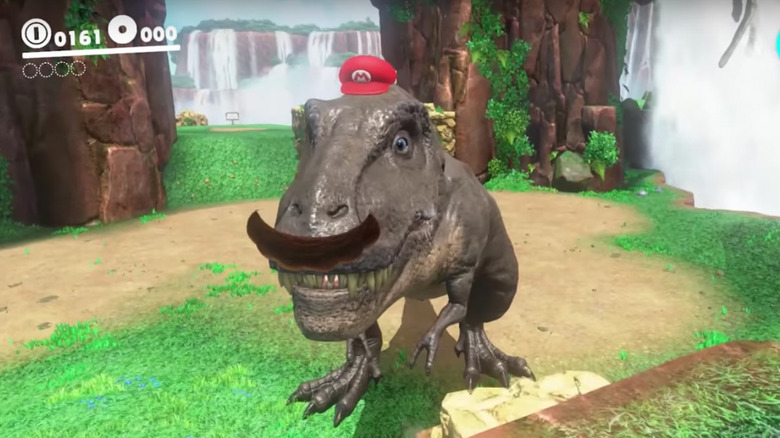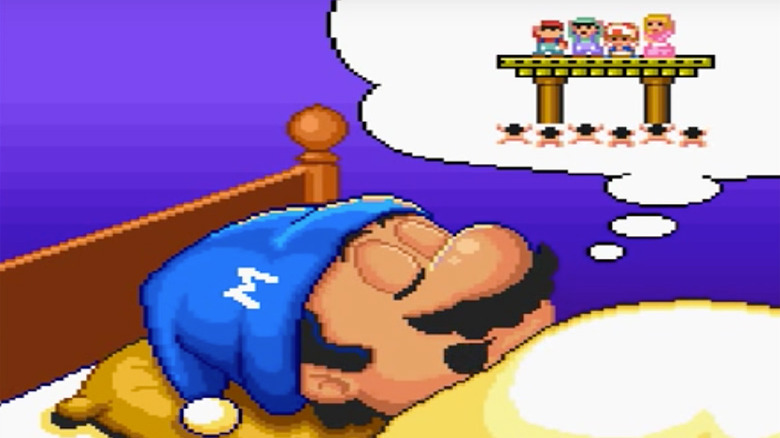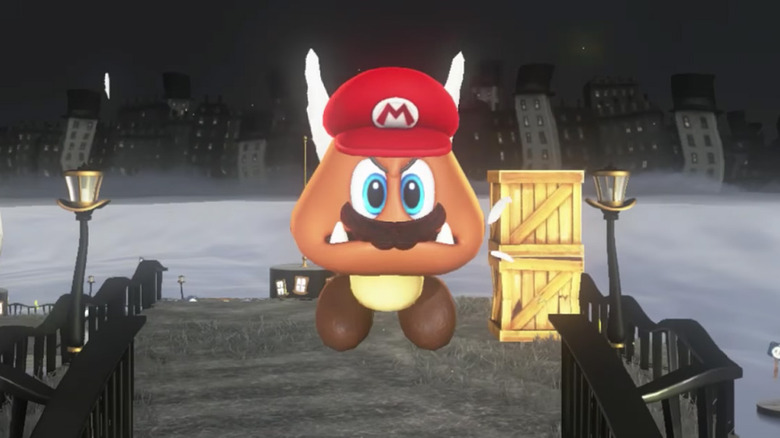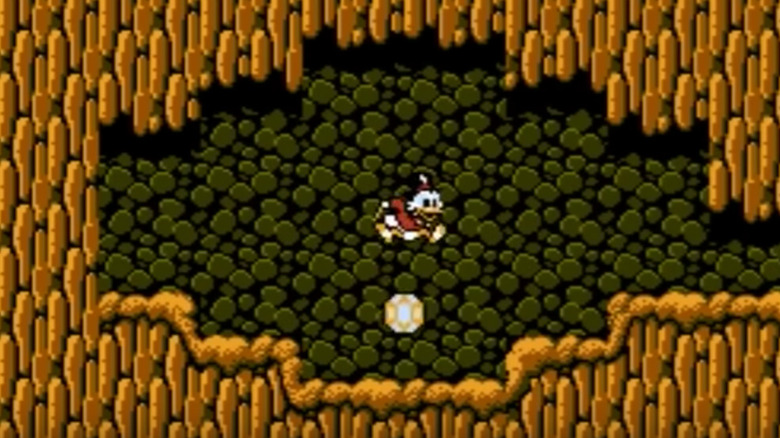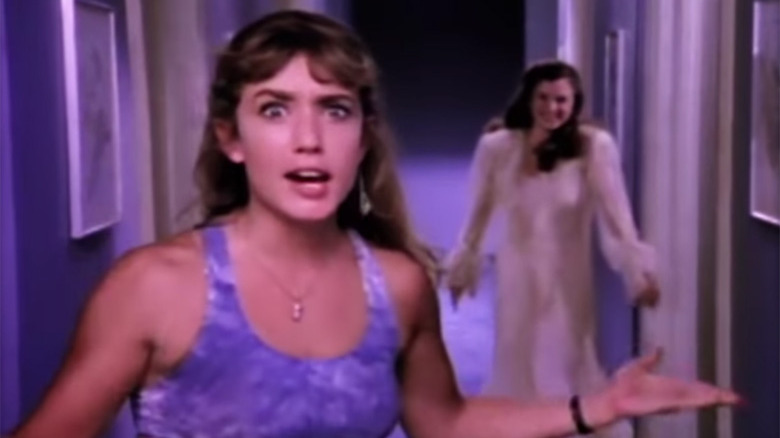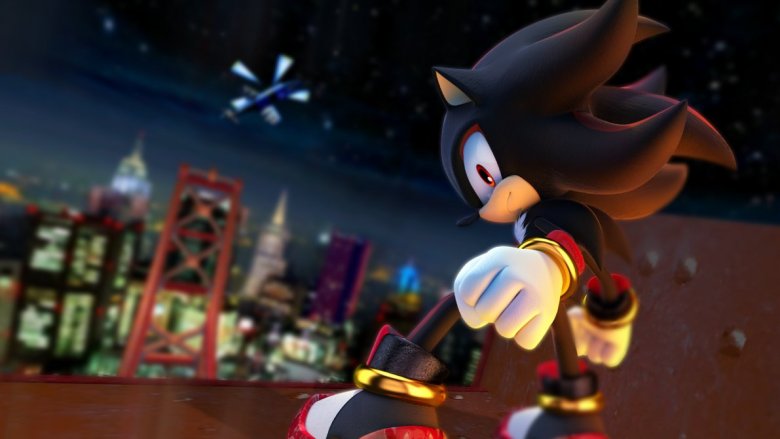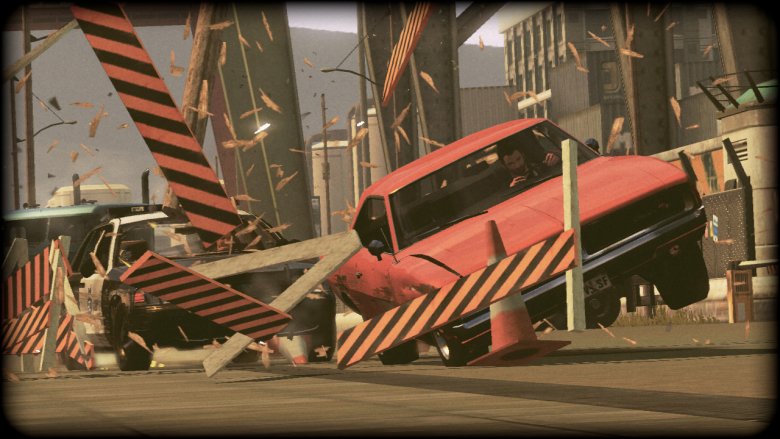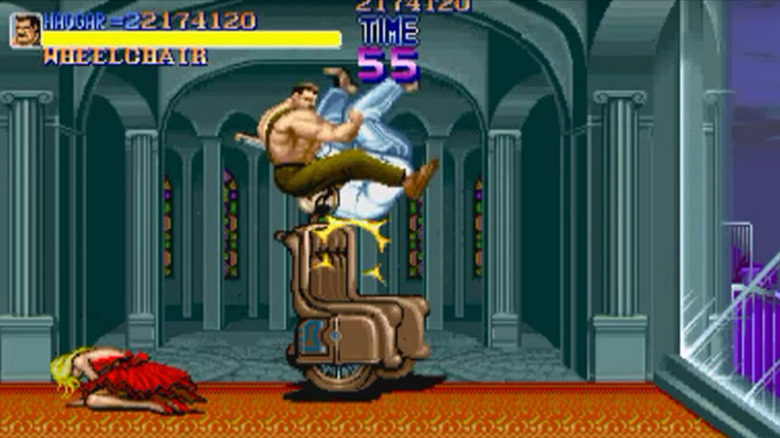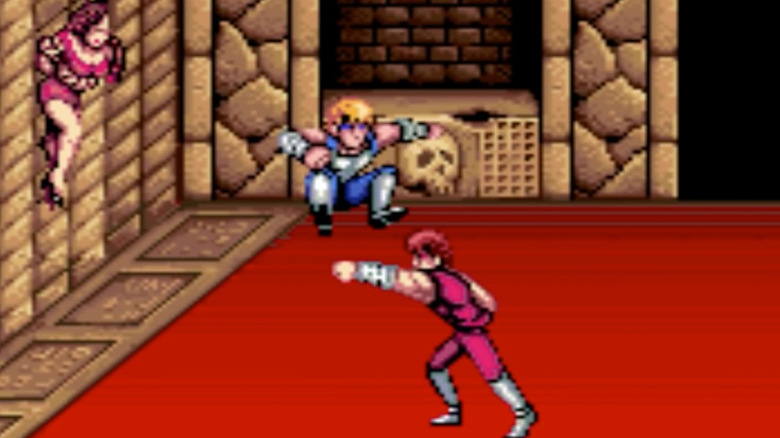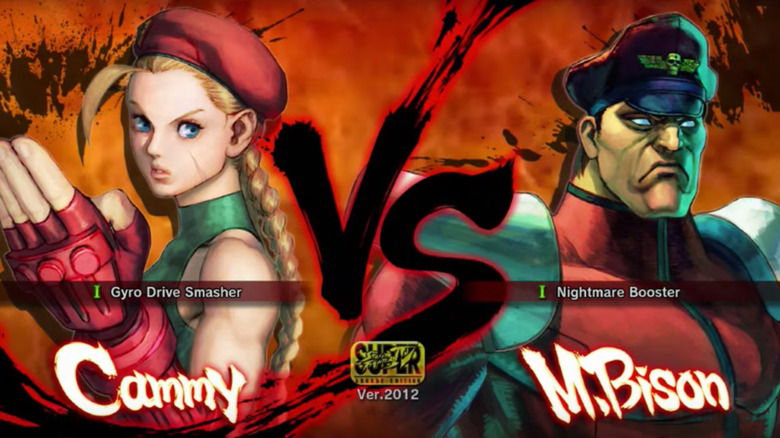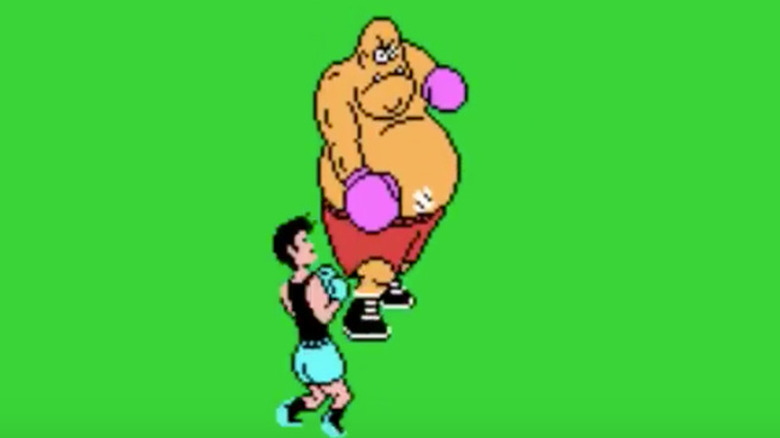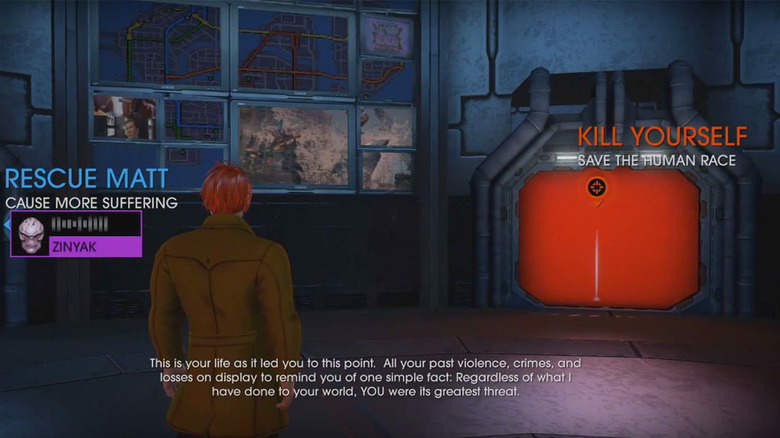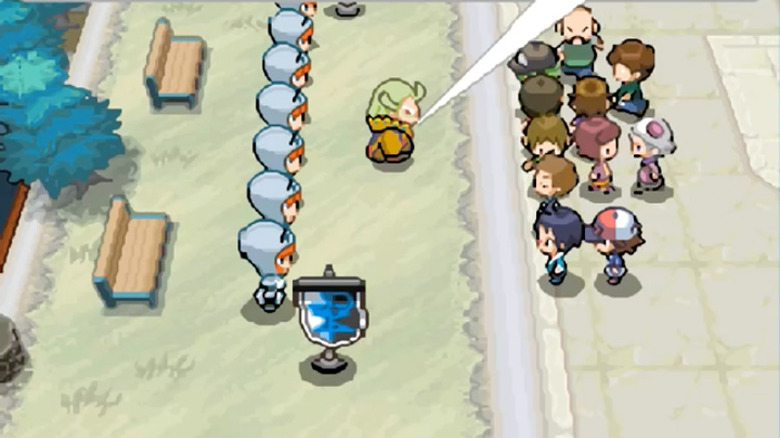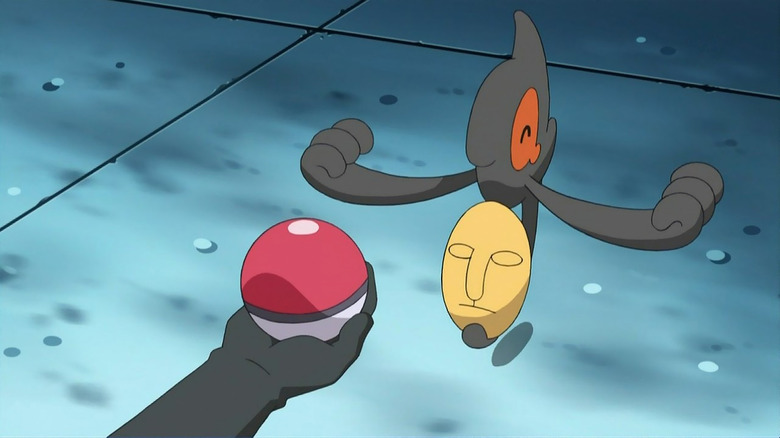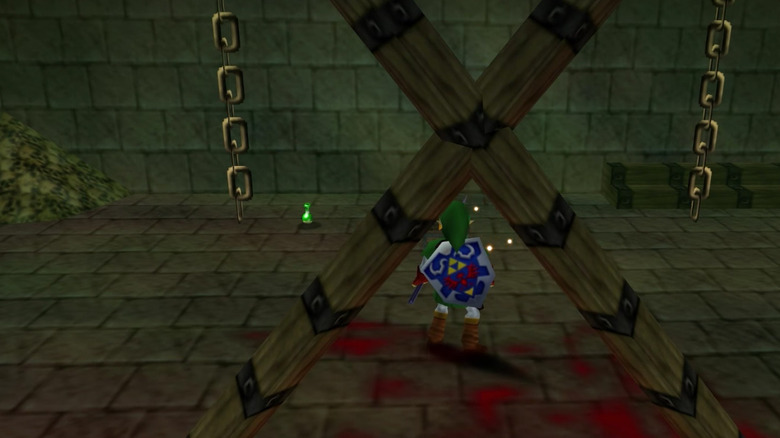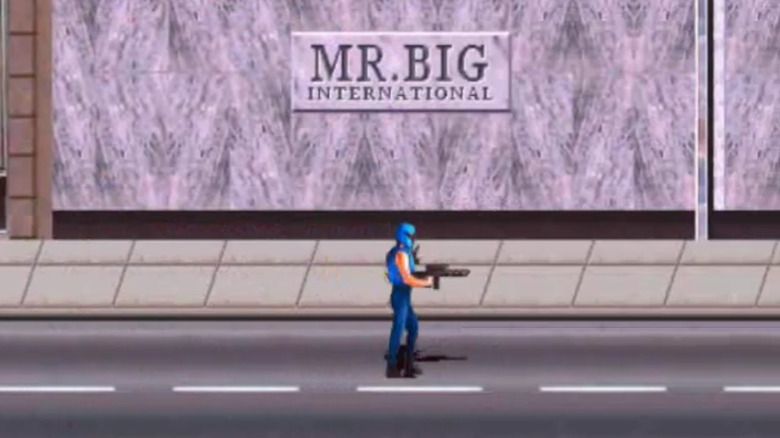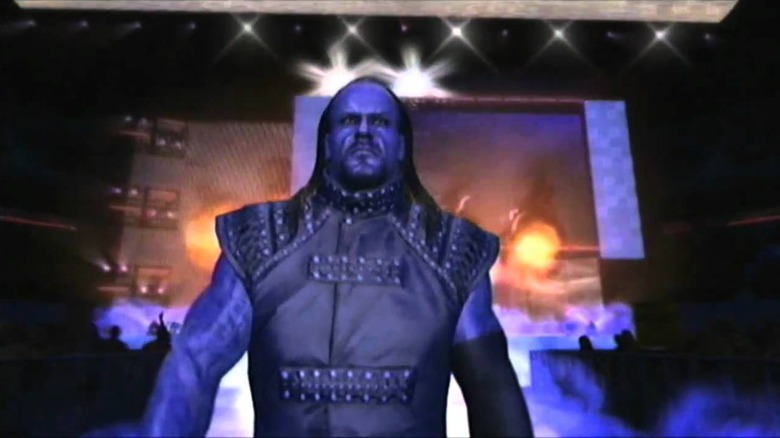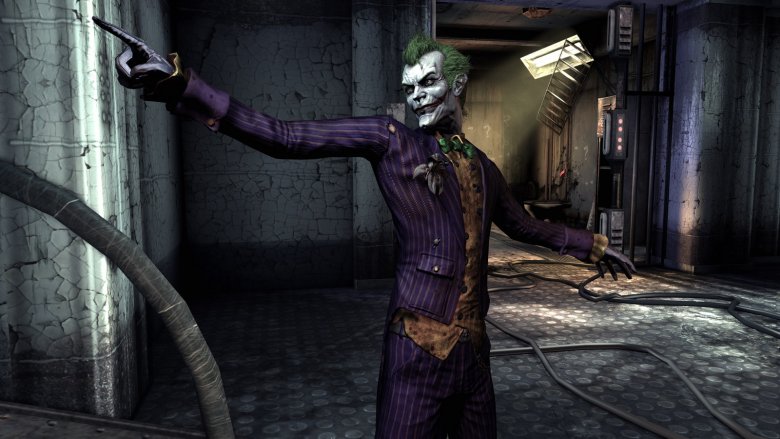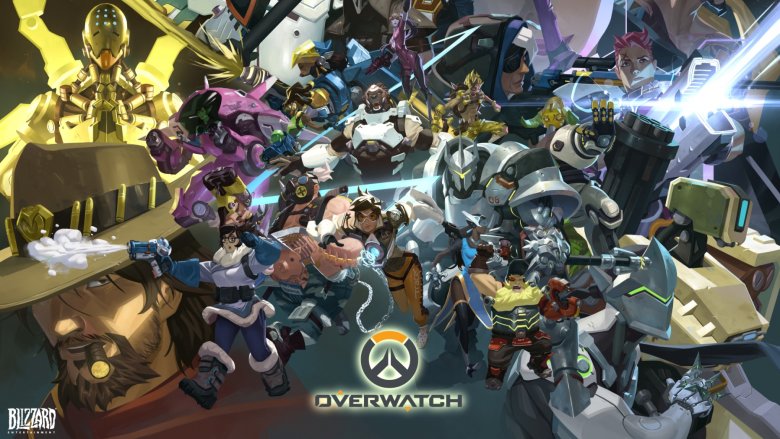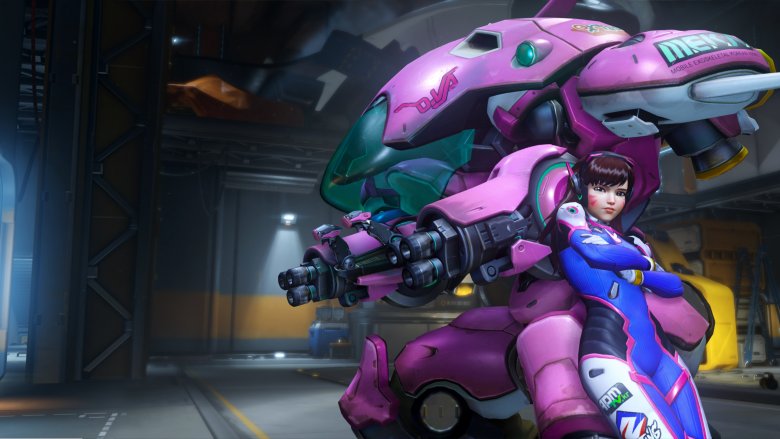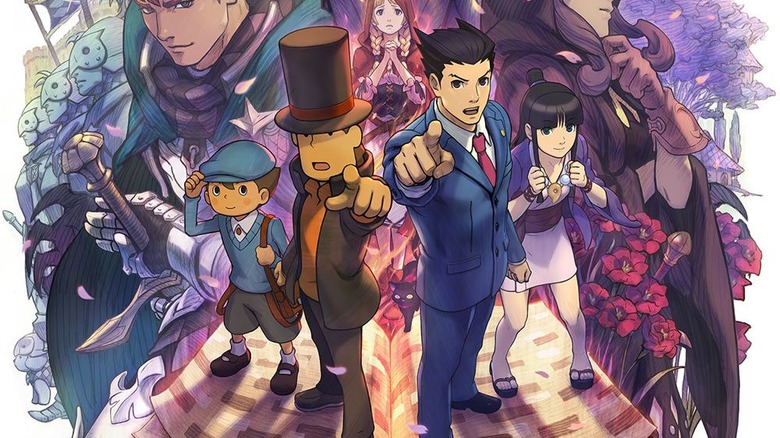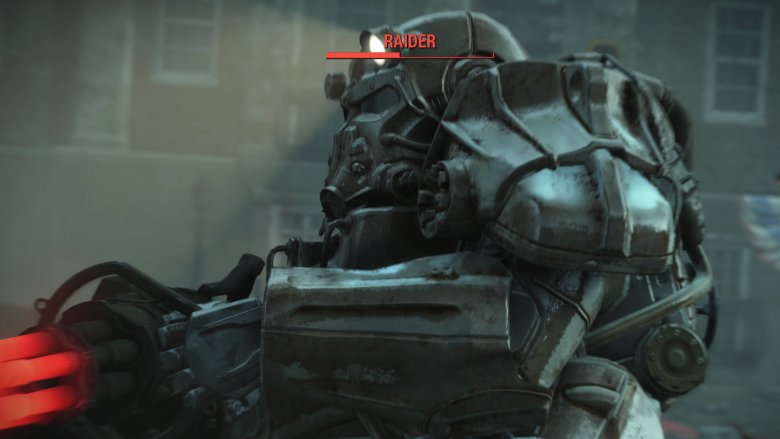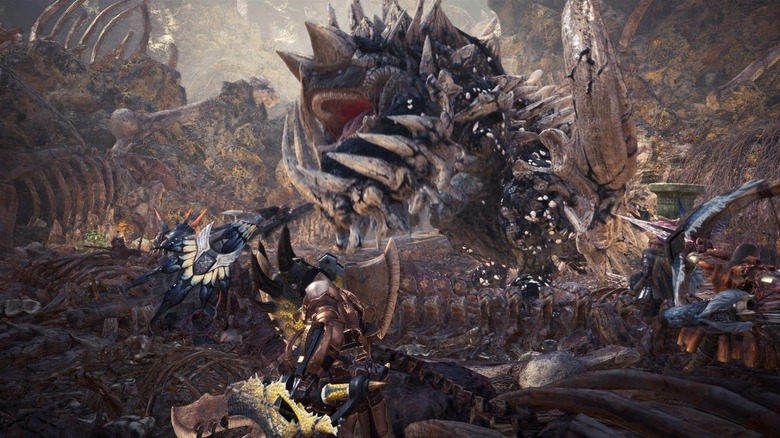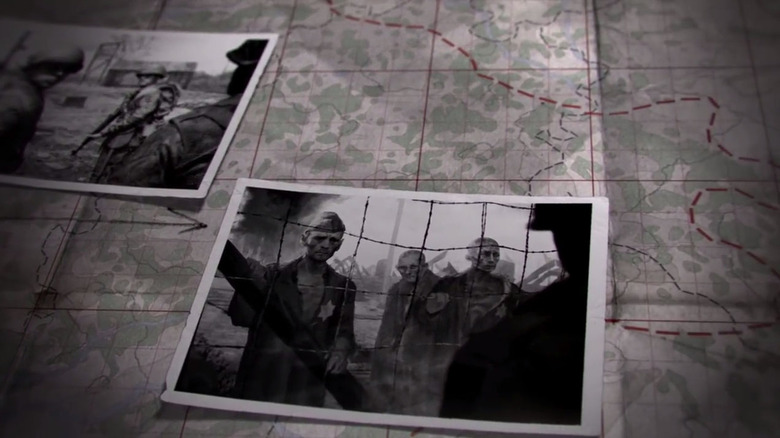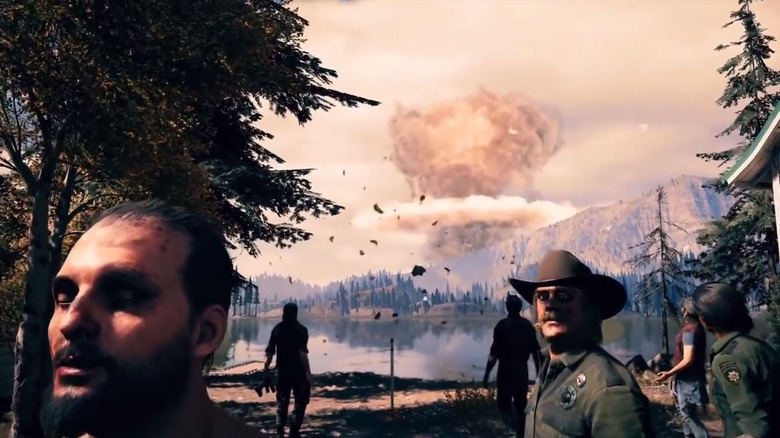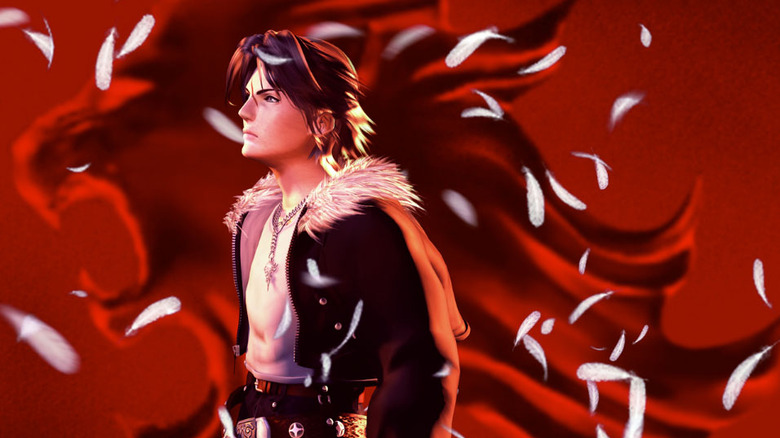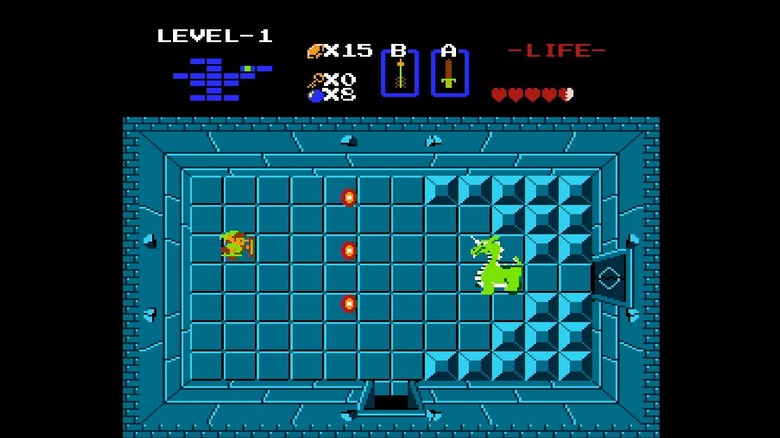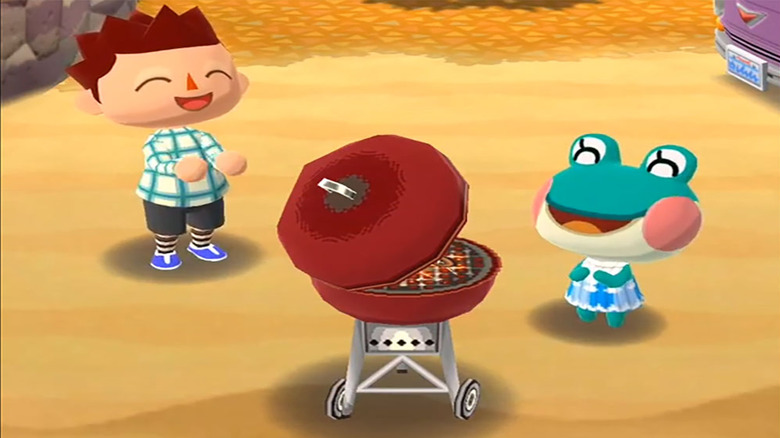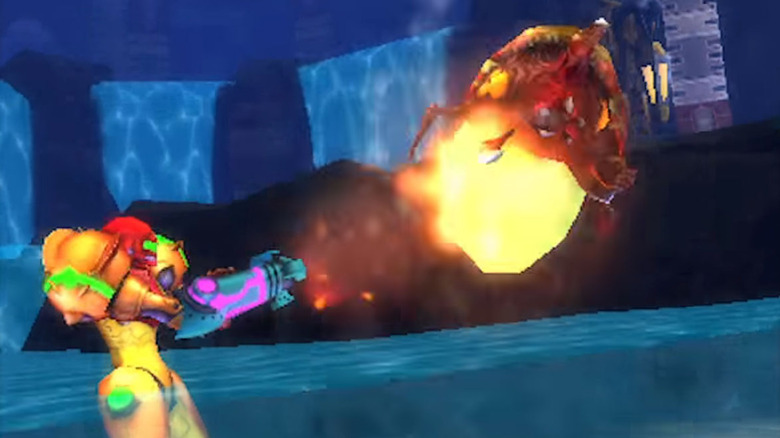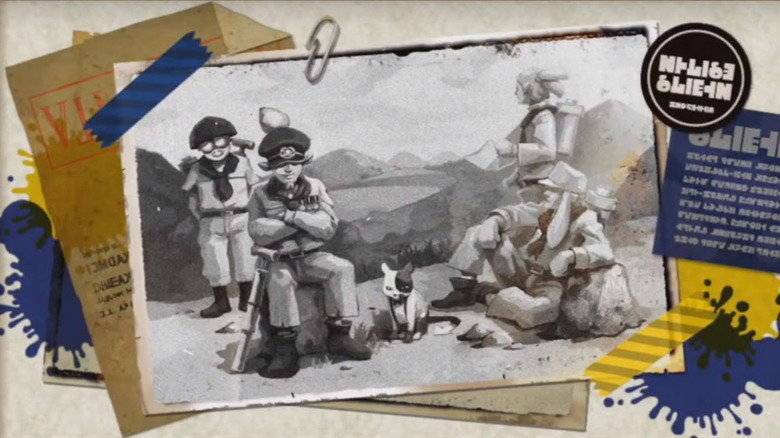The Messed Up Parts Of These Games Nobody Ever Talks About
Ever since a giant gorilla first threw a flaming barrel at an adventurous plumber and a very hungry circle was haunted by ghosts, video games have been weird. They've got their own strange sort of logic, and while that allows players to shrug a lot of things off, sometimes video games can get pretty upsetting if you stop and think about them for a second.
We're not talking about games that are meant to be, like, Silent Hill or BioShock — these are the otherwise "normal" games that take a sharp left turn into Nightmare Town.
A lot of the Super Mario games didn't actually happen
The Mario franchise has given Nintendo a friendly mustachioed mascot and provided gamers with some of the greatest console masterpieces of all time, but there's something weird about his adventures that's rarely pointed out: a lot of them didn't actually happen. Well, none of them actually happened, because "Plumber Saves Royalty From Sexually Frustrated Lizard" would be the biggest news story of all time, but you know what we mean. Even in the canon of the games, it's tough to figure out what Mario has actually done.
There are the obvious ones from the offshoots, like how all the Paper Mario games are presented as storybooks, but even the core series seems pretty suspect. Super Mario Bros. 2, of course, is revealed to be a dream at the end, but Super Mario Bros. 3 opens with a curtain raising, and the first few levels are full of platforms that cast shadows on the backdrop, like you'd see in a stage play. Even Mario 64 features Lakitu as a cameraman filming the action, implying that it's meant to be another performance. And to take it a step further, if the Koopa Kids were introduced in an adventure that's just a play, then that makes Super Mario World fictional, and since Yoshi's Island features Shyguys, characters that were introduced in a dream, that one didn't happen either.
If you really think about it, it's clear that Mario isn't a plumber, he's an actor — and one with a pretty vivid imagination. That explains why he spends so much of his free time having Go-Kart races and playing golf with his costars, including the ones who should be his mortal enemies. And it also explains why he got his start in what's essentially the Asylum Films knockoff of King Kong.
Mario's possession of the living has terrifying implications
Or maybe Mario is some kind of misshapen elder god who could enter your body at any time and cause you to jump off one of the many, many cliffs that surround your city.
Super Mario Odyssey might be the most bizarre entry in the series so far. Not only does it involve Mario flying around in a giant hat powered by the moon — which is actually less weird than when he was flying around space in a tiny planet shaped like his own head — but the core mechanic gives him the ability to possess both the living and the dead with the help of a magic hat named Cappy.
It's actually not so bad when he's just entering the spirits of, say, cars or manhole covers, and even the parts where you possess enemies make sense with video game logic. When he starts possessing people, however, things start to get troubling — especially since the humans in question bear very little resemblance to Mario, raising the question of just what Mario is. And to make matters worse, when Cappy possesses a T-Rex, he mentions that he can't hold onto it for long — implying that the people whose bodies you're using to solve the game's puzzles are actively fighting against their possessions. Somebody needs to get New Donk City an old priest and a young priest–quick.
DuckTales is about pillaging treasures from other cultures
DuckTales, a side-scrolling platformer loosely based on the cartoon of the same name, is unquestionably one of the greatest games of the NES era. Tight controls, fun level design, tons of secrets hidden away in nooks and crannies, and even gave the world the single best song 8-bit music could produce. And it's also about pillaging the treasures of other cultures in the name of increasing your personal wealth.
Admittedly, that's not something created for the game. The Scrooge McDuck of the cartoon (and the Carl Barks comics that inspired it) is built almost entirely around adventuring to distant lands and recovering "lost" treasures so that he can drag them back to his private vault in the great state of Calisota. In the game, though, you're taking a much more active role, and things don't take long to get sinister.
Sure, you might not mind ridding the world of Count Dracula. But when you're murdering a yeti by driving the point of your cane into his head so that you can add another ten pounds of gold to your money bin, or raiding the Congo for the world's largest blood diamond, you might start to have a few doubts about late-stage capitalism.
Commander Shepard frequently assaults a journalist
Bioware's Mass Effect games are all about choices. Over the course of three massive, galaxy-spanning games, the decisions that you make can (mass) affect not just the fate of humanity, but countless alien races. And you can also decide to assault a journalist because you disagree with the way she's reporting the facts.
Commander Shepard's conflict with Westerlund News reporter Khlaisah al-Jilani runs through the entire saga, with al-Jilani taking a pretty antagonistic stance against whatever the player's been doing in their battle against the Reapers. Naturally, you're given the option to combat the spread of #FakeNews by punching her square in the face in all three games, a moment that often winds up on compilations of the funniest moments in the series. Because as we all know, sending deadly special forces soldiers after journalists is hilarious.
On the one hand, the scene's a whole lot easier to take if you're playing the game with a female Shepard, as God intended. On the other hand, if you're playing with a male Shepard — like 83% of the people who played it — then you're basically pressing L2 to make some giant John Cena-looking space marine punch a woman in the face because she said something you don't like. "Renegade" doesn't really cover that one.
Night Trap recruits you for your next-level peeping skills
You've probably heard of Night Trap, the infamous game for Sega CD about saving a group of teen girls from vampiric "Augurs" by activating a mansion full of deathtraps. Not only was it a frequent punching bag for comedy writers thanks to its bizarre setup and its truly amazing theme song, it's also one of the main reasons that video games have ESRB ratings today.
But while it was billed as a sort of interactive movie, the player isn't just watching the events unfold — you're actually a character in the story yourself. The setup involves a task force with the unfortunate name of S.C.A.T., which has tasked you with monitoring the security cameras within the mansion. In other words, your character was presumably picked because you're already really, really good at spying on slumber parties.
And the weirdest part: if you don't do a good job with your voyeurism, the characters in the game start yelling at you to get it together and start doing a better job of straight up creepin'. That sort of gives a new meaning to having a very particular set of skills, and genuinely raises the question of whether it's better to have your neck blood drained by a gang of vampire drillers, or to be leered at through a bathroom mirror by the owner of a Sega CD.
Shadow the Hedgehog nuked a city
Shadow the Hedgehog from 2005 is a notable game for a couple of reasons. For one, it's the game that dares to ask the question of what would happen if Sonic the Hedgehog was cool enough to have a gun. For another, the truly bizarre level structure means the game has 326 possible endings, with names like "Coffin of Memories" and "Ego Dyed In Black."
The reason? The game lets you play each level with a heroic, neutral, or dark path, and has an ending for every single combination — and when we say "dark," we're not kidding. The game was heavily criticized for mature themes, like having Shadow say a couple of cusswords over the course of the story. Oh, and for having him blow up a city by setting off a series of bombs after talking about how much he hates all humans and wants revenge.
In a way, it's actually pretty impressive that it only took the Sonic franchise 14 years to go from saving your fuzzy friends by jumping on robots to large-scale terrorism and hatred for an entire species. Mario just got into go-karts and party games.
The missions in Driver: San Francisco never save anyone
Driver: San Francisco is an open-world driving game with a pretty interesting twist: after being rammed into the path of a semi-truck, a plainclothes cop named Tanner discovers that he has the ability to project his consciousness into anyone else in the city of San Francisco. In game terms, that means that you can take over any car in the city at any time, meaning that you can pretty easily win races by jumping into oncoming traffic and taking out your opponents with a head-on collision.
Naturally, Tanner uses this ability to help people, stopping crimes, and even helping out a couple of college kids who got in over their heads in the dangerous world of street racing. But by the end of the game, it turns out that the whole thing is all in Tanner's head. He never gained the ability to "shift" into other bodies–he just fell into a coma that came complete with a surprisingly vivid hallucination, with all of the missions being informed by bits and pieces of the news reports that are playing in the hospital room.
It's a great twist, but it also means that everything you've done in the game only happened in Tanner's imagination. All those crimes you stopped? Yeah, there wasn't actually a magic teleporting cop to help those people, so those poor kids who tried street racing probably wound up wrapped around a telephone pole or murdered by the mob when they couldn't pay up. But hey, enjoy that final level that takes place in the real world! At least you accomplished something there!
Final Fight has the city's mayor beat people up in the streets
Final Fight has the premise of the greatest '80s action movie ever made. A gang kidnaps the mayor's daughter, Jessica, in order to cement their control of Metro City. So naturally her boyfriend and his pal–a ninja–hit the streets to take the fight to the gang. And they're joined by Jessica's dad, Mike Haggar, a former pro wrestler who lives up to his campaign promise of being tough on crime by beating people in the streets with a lead pipe until everything works out okay.
This is bananas. Not the part where a pro wrestler is elected to public office — that's the part that actually makes perfect sense, given how well WWE Hall of Famers tend to do in politics. Rather, it's the bit where the mayor of a major American city takes his shirt off and starts dropping jumping piledrivers and German suplexes on his constituents. And that's before you factor in the idea that the police are so corrupt that this isn't just possible, it's necessary. There's even a level where Mayor Haggar beats a cop into unconsciousness outside of a bar, in front of a crowd.
If this actually happened, it would be the single biggest news story of all time, and it probably wouldn't be entirely positive. Now, there are definitely people who would be downright thrilled with a mustachioed brawler restoring a brutal order to the streets even if they didn't know about how the Mad Gear gang was legitimately evil and full of a near endless supply of leopard print Andre the Giants. But you have to think that most people would be at least a little put off by the part where he dropkicks a local businessman out of a wheelchair and through the window of a skyscraper to his death.
Double Dragon bros fight over the victim they just saved
If Final Fight is a disturbing look at the divisiveness of American politics, its beat-em-up cousin Double Dragon is at least a little more straightforward. You've got two brothers, another gang with an endless supply of members that seem to come from the same four very large families, and plenty of punches to go around. But what's really memorable about Double Dragon–aside from the translating error that referred to its main characters as Bimmy and Jimmy–is how it treats Marian, its standard-issue kidnapped girlfriend, which is pretty rough even by the standards of a video game made in 1987.
For one thing, in moment that's still pretty surprising, the game opens with Marian being punched in the stomach and hauled off by the bad guys, who make sure to give players an upskirt shot as she's being carried offscreen. They even left that one in for the NES version, although Nintendo did end up taking out the panty shots and having her just locked in a room rather than being dangled like a piñata at the end of the game.
Even worse, once the two brothers finally defeat the game, the two-player mode finds them turning on each other to fight over who gets the girl–you know, the one who's been viciously beaten and strung up in the gang's headquarters. They don't even untie her first, they just start going at it as soon as the enemies are down. Guys. Maybe this isn't the time.
Cammy was made as a new body for M. Bison
Pretty much every storyline in every fighting game is going to have something pretty weird about it, but few of them get quite as strange as Street Fighter. And when you consider that its major competition is about an interdimensional fighting tournament where an immortal shapeshifter sends a four-armed monster to rip your spine out, that's saying something.
It rarely gets weirder than in Cammy's origin story, though. While she would later find a place (and a surprisingly revealing uniform) as part of a British counter-terrorist strike force, she had her beginnings as a new, cloned body created for M. Bison, who managed to break out and find her own way. As a result, she has an understandable amount of sympathy for the other members of Bison's "Doll" program — all of whom seem to be teenage girls.
The good news, though, is that while Bison is still a ruthless mastermind dedicated to ruling the world, he has some surprisingly progressive views on gender.
Punch-Out!! has no concept of fair fights
Unlike other fighting games, which can get away with pulling some pretty weird stuff by setting their battles in Outworld or on various streets, the NES classic Punch-Out!! Makes an attempt at capturing the thrill of the actual sport of boxing. It's got the ring, the technical knock-outs, even a referee in the form of Mario who pops up to make the ten-count. It does not, however, feature a pretty important rule: weight classes.
If you've ever watched an actual boxing match, you may notice that you rarely see a big size difference between opponents, and there's a reason for that. Boxing matches are meant to be tests of skill rather than muscle mass, and pitting someone who weighs, say, 107 lbs against a gigantic heavyweight would likely result in the smaller boxer being literally murdered in the ring. Unfortunately, nobody at Nintendo got the memo. At a canonical weight of 107, Little Mac would be designated by the International Boxing Federation as a "Junior Flyweight." And yet, he routinely faces off against opponents like Mr. Sandman, who clocks in at a staggering 284 lbs. That's a difference of 177 pounds. That is an entire Connor McGregor.
If that wasn't bad enough, one of Mac's earliest opponents is King Hippo, who not only weighs in at "???," but is also a literal monster. It might be nearly impossible to beat Mike Tyson at the end of that game, but just making it through opponents that are 15 weight classes ahead of him, teleporting punch wizards and some kind of ogre king make Mac the undisputed greatest of all time.
Saints Row IV calls you out for being terrible
Ever since Grand Theft Auto III hit consoles with its "Rampage" missions, open world games have allowed players to go wild with massive amounts of chaos. The Saints Row franchise takes that to a whole new level — in those games, wanton destruction isn't optional, it's the entire point, and you're rewarded handsomely with every explosion. It's an incredible amount of over-the-top fun... right up until the moment where the game calls you out for being the greatest monster in human history.
In Saints Row IV, Earth is attacked by an alien warlord named Zinyak, who makes a compelling argument about why humanity is better off without the player and the rest of the Saints. "How many people have died," he asks, "because you decided driving on the sidewalk is faster than the road, because you used a rocket in place of a bullet?" If you've played the Saints Row games before — or GTA, or Mafia, or any other open-world crime simulators — the answer is a lot.
It's something to think about, especially when Zinyak gives you the choice of killing yourself to ensure that he spares the rest of the human race, or to continue with the game and guarantee the destruction of Earth. The trick? If you choose the noble sacrifice, you get an instant game over, and the knowledge that Zinyak lied and killed everyone else anyway. Earth's destruction is imminent, and the only thing you can do is think about whether you or Zinyak caused the most suffering.
For a game about beating people up with a marital aid taped to a baseball bat, that thing gets dark.
Team Plasma had a good point
For years, the Pokémon franchise has received criticism from people who see it as a video game version of dog-fighting that encourages children to pit their pets against each other in vicious battles. They've always been able to dodge this by presenting battles as something more like martial arts, where people can spar and even compete with each other without the vicious violence of a cockfight. Well, that is until a group of villains came along and started making that point within the games themselves.
In Pokémon Black and White, players met Team Plasma, a group of RenFaire cosplayers who took the controversial stance that maybe imprisoning sentient animals in tiny balls and only letting them out to beat each other up might not be a great idea. Instead, they encouraged trainers to release their teams to a peaceful life in the wild. It even leads to a few interesting debates within the game, before it all goes sour at the end.
Needless to say, they eventually turned out to be a garden-variety evil organization that wants to steal your Pokémon for their own evil purposes, but a few of them truly believe in the cause and wind up taking care of wild Pokémon after the team's defeated. Either way, they bring up a lot of points about how their society is built in a game that probably shouldn't have brought it up.
You enslave dead people's souls in Pokemon
Really, though, the whole thing about cockfighting is a very basic, surface-level reading of what's going on in the Pokémon games — if any of those people complaining about that actually bothered to dig any deeper, they'd find that people making adorable animals duke it out in the streets is the least of their worries. There are references to wars, organized crime, and ten year-olds wandering around the country attempting to capture literal world-destroying gods. And then there's the part where you can imprison the souls of the dead.
No, seriously. It turns out that "Ghost" isn't just a convenient description. The Pokédex, a nearly endless source of horrors for anyone who bothers to look, explains that the Ghost type is full of genuinely terrifying spirits. Drifloon abducts children. Chandelure burns away your soul and leaves your body behind as an empty husk. And Yamask?
Yamask used to be a person.
According to the 'Dex, Yamask "arose from the spirits of people interred in graves" and "each of them carries a mask that used to be its face when it was human. Sometimes they look at it and cry."
Until you came along and trapped it in a Pokéball to go fight Growlithe or whatever, it spent all its time mourning its former life and staring at a mockery of its human face. Equally concerning: it grows into a sarcophagus monster that eats tomb raiders, meaning that grave robbers are such a prominent thing in the world of Pokémon that creatures are literally evolving to subsist on them.
Ocarina of Time reveals Hyrule's bloody history
When it comes to Zelda games that get a little freaky, the one that usually comes to mind is Majora's Mask. It is, after all, a game where the actual moon is trying to kill you, and that's maybe the least disturbing thing about the whole enterprise. What's often forgotten, though, is that Ocarina of Time has something that's way more visceral than anything its sequel has to offer.
As Link makes his way through the Shadow Temple — which is said in the game to contain "Hyrule's bloody history of greed and hatred" — the standard dungeon hazards give way to much more realistic torture devices. You find guillotines, spiked boards, and statues of the Grim Reaper swinging razor-sharp scythes. Delve even deeper, and eventually you wind up in a room with a single bloodstained St. Andrew's cross, named for the martyr crucified on it, and a pile of skulls in the corner.
The message here is pretty clear: dig deep enough, and you'll find that even Hyrule is a kingdom built on brutality and torture. Just something to think about next time you're trying to restore "peace" to the kingdom and stop Gannon from, you know, doing all the stuff that Zelda's ancestors already did.
Castlevania's weirdest boss fight ever
Ever since Castlevania hit the NES with the promise of fighting all of your favorite movie monsters on a trip through Dracula's castle, the boss fights have provided the franchise with some of its most memorable moments. The buildup to Dracula–who is himself often shown to be more like some kind of nightmare Satan than a vampire–features some incredible moments as you take on his legion of monsters. There's Balore, the giant cyclopean demon trapped in the depths of the castle, Beelzebub, a massive devil suspended on chains swarming with flies, a floating sphere made of corpses called Granfalloon–and that's before you get to the part where you fight Death itself, and win.
In Castlevania: Aria of Sorrow, the most memorable fight comes when hero Soma Cruz finally faces Graham Jones, a would-be heir to the power of Dracula. Halfway through the battle, he turns into a full-on Evil Dead-style geyser of blood, and then the boss designs officially go even further off the rails than they'd ever gone before.
In Graham's second form, he sits in the heart of two giant naked women, conjoined at the torso, who have seemingly been flayed of their skin so that their organs can hang out while they attack with a spinning crown of skulls. That's pure madness even by Castlevania standards, and the weirdest part is that Graham isn't even the final boss. The designers of this game somehow thought they could top a boss made up of two giant women whose eyes were joined together by something that we can only hope is melting cheese. It turns out that they couldn't, and haven't been able to ever since.
Narc: drug addiction is punishable by death
When it was released in 1988, Narc was billed as the first video game with a strong anti-drug message, which is sort of like saying that cocaine is a strong anti-drowsiness medicine. The entire game is about a pair of cops—the creatively named Max Force and Hit Man—taking to the streets with machine guns in each hand so that they can ruthlessly gun down what the original arcade flyer refers to as "junkies" and "punks."
Seriously: while the bosses of each stage are meant to be the dealers, the enemies you massacre by the hundreds are basically just guilty of possession. And considering the second stage takes place at a "hippie" marijuana farm covered in tie-dyed peace signs, they're being executed in the middle of the street for something that's since become legal (and prescribed by actual doctors) in several states. Oh, and in the third stage, Max and Hit decide that they should also shoot their dogs for good measure.
Regardless of where you fall on the hot-button issue of decriminalizing drugs, we can all probably agree that this is at least a little bit harsh. Honestly, considering that the final boss of that game, the corporate kingpin known only as Mr. Big, is actually a twelve-foot severed head with a twisted-up neck that rides around on a Roomba, it's hard to blame anyone who lives in that world for needing a little something to take the edge off.
Mega Man throws the Metal Blade out with the bath water
Since his original NES appearance in 1987, Capcom's Mega Man has appeared in eleven games in the core series—plus eight more in the Mega Man X franchise and a few dozen spin-off titles—and each one begins the same way. Mega Man is back to square one, having apparently lost every weapon and item he worked so hard for in the last game, woefully unprepared to fight for everlasting robo-peace.
It's happened so often that gamers don't even really notice it anymore, and to be fair, there's actually a canonical reason for it. In the Mega Man comics, it's revealed that Mega Man, having been created as a peaceful robot who only takes up the arm cannon when he needs to save others, hates being used for violence and is always eager to get rid of the weapons as soon as the crisis has passed.
But there are two big problems with that line of logic. First, while pacifism is certainly a noble goal, you'd think that after about the third or fourth time that this happened, Rock might realize that he could probably save a lot more people in a lot less time if he just kept the Metal Blade handy instead of throwing it into the furnace the moment he got home. Second, while the evil Dr. Wily is responsible for building most of the Robot Masters, at least a few of them were built by Mega Man's creator, Dr. Light. If he could build fully compatible Thunder Beams and Ice Slashers once, there's no reason that Mega Man should ever be going into battle without them.
WWE Smackdown vs. Raw 2011's insane Undertaker storyline
Capturing the feeling of pro-wrestling in a video game is trickier than it sounds. Unlike traditional fighting games, where you throw punches, kicks, and fireballs at someone until their health meter is out, wrestling matches have an entirely different structure built around telling a story, complete with near-falls, comebacks, and devastating finishing moves. Figuring out how to do that without making a game that's tedious to play is tough; but if you do it, you can make a wrestling game people will remember for years.
Or, if you're Smackdown vs. Raw 2011, you can just try to recreate the sheer insanity of pro-wrestling storylines and wind up making something that might actually be weirder than anything that ever happened in the ring. And considering that RoboCop once showed up to fight Ric Flair, that's saying something.
It happens in the game's career mode, where your chosen grappler attempts to be the first wrestler to beat the Undertaker at WrestleMania. Along the way, you do everything you'd expect a wrestler to do: you wrestle matches, cut backstage promos, ask the bosses to put you on the card, steal a mystical urn and use it to capture a disembodied spirit, go into an extended hallucination sequence where you enter a spooky nightmare world and compete against fourteen faceless druids in a Royal Rumble match, receive a visit from the literal ghost of Paul Bearer, have matches with retired wrestlers who may or may not have used a time machine to come to the future.
You know, standard pro-wrestling stuff.
Skyrim: It must've been the wind
Bethesda's 2011 hit Skyrim is a staggering achievement in game design. It's a beautiful world, stretching from the dizzying heights of the Throat of the World to the rocky depths of Markath, and you can walk around it for hours and always find something interesting and new to look at. In fact, the only thing more impressive than the world itself is how Bethesda managed to populate it entirely with people with the intelligence of a sack of doorknobs.
Need proof? Just sneak up to any enemy hideout and shoot someone with an arrow from a hundred yards away. If you're stealthy enough, they'll give up looking for you after a few seconds, and then dismiss being shot in the face by saying something like "huh... must've been the wind." They will even say this if they have an arrow sticking out of their own body as they step over their comrades who have inexplicably just dropped dead with arrows sticking out of their bodies, too.
To be fair, Skyrim is set in a world where people can knock down mountains by shouting and where you're more likely to run into a dragon than a dog. It's entirely possible that the wind itself could turn out to be some malevolent force that occasionally just flings arrows at people. Maybe "must've been the wind" isn't a sign that they're giving up the search, but actually a chilling resignation to there being some forces from which there can be no protection. Or maybe they should try looking a little harder at that heavily armed cat-person crouching in the bushes. That could work, too.
Batman: Arkham Asylum: The Joker's plan is terrible
Arkham Asylum is undeniably great. In the long history of Batman's appearances in video games, it was the first time that any game accurately captured what it must be like to actually be Batman: swooping down on villains, taking out henchmen with effortlessly brutal counters and bone-crunching finishing moves, and stealthily inspiring fear as you pick them off one by one. Unfortunately, it's also built around the Joker orchestrating a complicated master plan that you can't think about for more than four seconds without realizing how genuinely terrible it is.
The weirdest part is that there's enough smart stuff in there–like the Joker orchestrating the transfer of a bunch of his henchmen to Arkham from Blackgate Prison so he'd have extra muscle–that it almost seems like a brilliant plan. At the very least, for most of the game he comes off smarter than whoever decided to put Poison Ivy into an asylum right next to a giant greenhouse. But then you get to the end, where it turns out that the Joker's plan is to turn both Batman and himself into giant hulked-out Titan monsters so that they can punch each other to death, which is utterly foiled when Batman just decides not to turn into a monster.
The most hilarious part is that after jacking himself up on Titan serum, the Joker insists that Batman has to transform, because "it's the only way to beat me." Please note this happens about two minutes after the Joker watches Batman defeat not one, but two Titans, at the same time, while also fighting a bunch of regular henchmen. The Joker might be crazy, but he's not usually that stupid.
Wait, no. The actual most hilarious part is that Batman's plan is somehow even worse, and involves putting explosives on his own fists and then setting them off while punching his arch-nemesis, which somehow does not result in his arms blowing off and landing somewhere in the next county. Compared to that, maybe the Joker's plan isn't that bad after all.
Overwatch is the world's least secret secret organization
Overwatch is one of the most successful games of all time, and it's easy to see why. It's got simple controls that are easy to learn and rewarding to master, incredible character designs, and a deep lore behind its storyline that hints at a well-crafted setting with optimism and danger in equal measure. It's so good, in fact, that we've all just decided to ignore that the very first thing that happens in the game should probably not be happening at all.
If you just jumped right into the shooting part and skipped over all that lore, the basic idea is that the Overwatch organization was disbanded five years before the events of the game by the order of the United Nations. Even though they'd saved the world ten times over in the war against sentient robots called Omnics, the group fell out of favor when some of its more secretive and morally dubious activities came to light. After an explosion at their headquarters that left two of its commanding officers presumed dead—the characters who would then become Soldier: 76 and Reaper—all activity even related to Overwatch was outlawed.
Needless to say, nobody wants to play a video game about Tracer hanging out on the couch marathoning the new season of Black Mirror, so Overwatch opens with Winston recalling all of the former operatives to active duty in order to stop a new crisis. Since just being part of the group is illegal, however, you'd think that the U.N. might object to that and send someone to stop it—which, in Winston's "Recall" animated short, they do. The only way any of this is going to last long enough for the team to actually do anything is if they keep a low profile.
Which, of course, is the exact opposite of what they actually do. To be fair, it's hard to keep things secret when your starting point is a talking gorilla from the moon putting out a YouTube video to get the band back together, but maybe you could try to avoid having six-on-six gunfights in the middle of London and Hollywood that involve hot-pink mech suits, time-traveling fighter pilots, and... whatever the hell Road Hog is.
But Overwatch's insanity doesn't end there–that's just the beginning.
In Overwatch, South Korea sent teenage gamers to fight Robot Cthulhu
One of the cooler pieces of Overwatch's backstory is that the robots who attacked humanity during the Omnic crisis took all kinds of different forms. There were standard infantry robots like Bastion, 20-foot Goldar-looking monsters stomping through streets, and even a bunch of robot ninjas working for the Shimada family in Japan. The coolest, though, is the unnamed robot that occasionally rises from the sea to attack South Korea.
While it's never been depicted in any official art, the Overwatch website describes it as a "massive lumbering construct" and a "monstrosity" that emerges from the ocean every few years with a twisted new form, before descending to rebuild itself once they fight it off, "defeated but not destroyed." In other words, it's half-Godzilla, half-Cthulhu, and all gigantic robot murder factory, and it's been out there for 20 years. So naturally, the only way to deal with it is to send a teenage Starcraft player out there to fight it while streaming the whole thing to her adoring fans.
No, really. That's D.Va's actual, canonical backstory. And honestly, as fun as that game's arena battles are, maybe all those heroes should get together and do something about Mechathulhu before they start worrying about how Reaper might be up to some shenanigans in Hollywood. It seems like that might be a pressing concern.
Professor Layton vs. Phoenix Wright and the witch-burning memory loss village
When the puzzle-solving Professor Layton franchise collided with Phoenix Wright and the bizarre legal system of the Ace Attorney games, they landed in the mysterious fairy tale city of Labyrinthia. While they were there, they had to solve mysteries and win court cases to prevent the citizens from burning a young woman to death for being a witch, which involved presenting magic spells from a book called the Grand Grimoire as evidence. Eventually, though, there was a twist, and it turned out that Labyrinthia wasn't in some magical world after all.
Instead, it was a secret research facility built by a chemical manufacturer and stocked up with a population of volunteers who had their memories erased so they could live out their lives in a D&D fantasy world where they occasionally threw teenage girls into a raging fire for the crime of witchcraft, and developed an unhealthy obsession with logic problems. Now buckle up: that's not the messed up part.
The messed up part is that this isn't the first time this sort of thing has happened to Professor Herschel Layton, nor is it the second. While it's certainly a new situation for Phoenix Wright, whose problems mostly stem from being surrounded by murderers, liars, and idiots, this stuff happens to Layton all the time. The first game takes place in a village populated entirely by robots that are indistinguishable from humans who were created to protect a treasure. The third game is even weirder, involving a bad guy who builds a full-scale underground replica of London beneath the real London in order to convince Layton that he has a time machine. Three makes a pattern, and with his skill at solving puzzles, there's no reason for this game to not start with Layton just straight up saying "fake city," turning around, and walking out.
Fallout: The Brotherhood of Steel makes a very good point
In the post-nuclear world of the Fallout games, the Brotherhood of Steel is one of the most enduring factions, appearing in every game in the franchise. They have a legacy that stretches back to the days before the Great War—which, fortunately for all of us, isn't scheduled to happen until 2077—and they're probably the most technologically advanced group in the games. Which makes sense, because they're devoted to recovering and preserving the advanced technology that was all but lost in the apocalypse.
It's that dedication to protecting tech and knowledge that's put them into conflict with Fallout's player characters more often than not. With the exception of a few isolated cells, the Brotherhood would much rather save a suit of power armor or a plasma rifle than a person's life, and not only do they often refuse to share their knowledge with outsiders to assist the people of the wasteland, they're also known for descending onto entire communities and wiping them out in what they usually call a Scourge. Basically, as they say in Fallout: New Vegas, their philosophy is that everyone knows how to make more people, but very few people know how to make a plasma rifle.
And here's the thing: they're absolutely right. The wasteland of the Fallout games might be an endless nightmare of Super Mutants, Ghouls, Raiders, and people inexplicably leaving individual bullets and narcotics in their mailboxes, but there are plenty of human settlements–and in the West, they're actually thriving. If scientific discoveries and advanced technology are lost, however, they're lost for good until civilization claws its way back to the point where those discoveries can be made again, a process that may take centuries. If you're looking at preserving the knowledge of an entire civilization...well, the people are a renewable resource. That's a grim sort of calculation, but that's exactly what makes Fallout so compelling.
Monster Hunter: World glorifies trophy hunting
Monster Hunter: World is all about the loot. Venture into the field, slay your target, harvest their remains, and take your trophies home to build bigger and better gear. That'll let you hunt even bigger beasts, take their body parts, make even better weapons, and so on. It's a lot of fun — until you think about what you're doing to the environment in the process.
See, hunting animals just so that someone can have their stuff happens in the real world, too. It's known as trophy hunting, and it's bad news. Removing predators from the ecosystem messes with the animal population, leading to less biological diversity and weaker critters. Scavengers end up without food and die out. The overabundance of grazers wreaks havoc on the local vegetation, too, leading to overgrazing and all other kinds of nastiness.
Even worse, in Monster Hunter: World, some of the creatures you're after are incredibly rare. You're not just hunting them down, you're hunting them into extinction. There's pretty much no way to give that a positive spin — but hey, at least that Nergigante armor looks cool, right?
Call of Duty: WWII more or less ignores the Holocaust
There have been games set during World War II before, but Sledgehammer Games' take on the conflict that defined the greatest generation is something different. Instead of a digital slaughterfest that just happens to have a historical skin, the folks at Sledgehammer said that they wanted Call of Duty: WWII to "honor and respect" the people who died in the clash between Axis and Allied forces. They wanted to illustrate World War II's violence "so that we never let it happen again."
So, how does Call of Duty: WWII deal with the Holocaust, the Nazi's ethnic cleansing program that claimed the lives of up to 20 million people? It doesn't. Not really, anyway. The Holocaust comes up briefly during the game's epilogue while the hero, Red, searches for a captured soldier named Zussman, a Jewish-American soldier who happens to be the main character's best friend. Red's team run across a concentration camp. We see a few photos, and Red says that "what I saw stayed with me forever," but that's it. As Mashable notes, the entire sequence takes less than half a minute, doesn't acknowledge the victims at all, doesn't refer to genocide or use the word "holocaust," and is over after a brief 38 words have been spoken.
Look, we know that Sledgehammer wanted to focus on soldiers' "boots on the ground" experience, but just ignoring one of the biggest atrocities in human history? Honor and respect that is not.
Nobody in Far Cry 5 cares about nuclear war
You'd think that the nuclear apocalypse would be a big deal. At the very least, you'd think that people would be, y'know, talking about it. Not so in Far Cry 5. While you're busy joining militias and rescuing a small Montana community from an ambiguously evil cult, the rest of the world is blowing itself to bits and nobody around you seems to care.
In fact, if you're not paying attention, you might miss the unfolding global catastrophe — which ends up playing a major part in the game's ending — entirely. In Far Cry 5, discussion of nuclear war is confined to optional radio broadcasts on one of the in-game radio stations. If you choose to listen to something else, you'll miss it. The only real indication that something's going on comes from the Eden's Gate cultists, but one, those apocalyptic warnings are so vague that they're virtually meaningless, and two, those guys are flat-out crazy, so there's no real reason to believe them until the bombs start falling.
It's a weird choice, even if Ubisoft claims that it's entirely intentional, and more than one player has ended up entirely baffled by the whole thing. A well-executed plot twist is one thing. Pretending that nobody is going to care when the world is on the verge of destruction is something else entirely, however, is just plain wrong.
All of the characters in Final Fantasy VIII have brain damage
Halfway through Final Fantasy VIII, the members of your party make a big discovery: they all grew up together. That's right: Squall, Selphie, Seifer, Zell, and the rest were all raised in the same orphanage, one run by a sorceress named Edea — who you already know as the game's big bad — and her husband Cid, who just happens to be the principal at the SEED training facility where everybody lives.
It's all quite a coincidence, but the game does explain why Squall and the gang don't remember that they're all basically brothers and sisters. Quite simply, their brains are all messed up. As it turns out, the Guardian Forces that you fuse your characters with — which, in Final Fantasy VIII, is something you need to do in order to raise your stats — draw their power from the same area of the brain that stores memories. The more that you use a Guardian Force's power, the more that you forget.
That should be game-changing information, but nobody really seems to mind. In fact, after that big revelation, everyone continues using the Guardian Forces like it's no big deal. You'd think that at least one member of your party might want to reconsider giving themselves a magically-induced concussion every time they step into battle, but nobody's actually that concerned, and the topic never comes up again.
The Legend of Zelda takes place after the end of the world
Believe it or not, The Legend of Zelda games have an official timeline, and, well, it's complicated. Essentially, after The Legend of Zelda: Ocarina of Time, Zelda's chronology splits into three different branches, each of which makes up its own series. One fork continues on from Ocarina of Time's adult era, after the legendary hero has disappeared because he went back in time to live out his childhood in a (now) alternate timeline, paving the way for Wind Waker and its spin-offs. Another branch follows Link back to the past, where he's successfully changed the future, leading to games like Majora's Mask and Twilight Princess. Confused yet?
Don't worry about it. For our purposes, we only care about the final timeline. That's the one where Link challenges Ganondorf and fails. Ganon gets the Triforce and takes over, a giant war breaks out, Hyrule falls into decline, and everything goes sideways. That's where you'll find games like A Link to the Past, Link's Awakening, and the original NES Zelda games.
In fact, according to The Hyrule Historia, Nintendo and Dark Horse's official guide to Zelda chronology, by the time that the original The Legend of Zelda takes place, Hyrule has just a fraction of its former glory. It's shrunk from a sprawling empire to a single kingdom, and it's been entirely conquered by Ganon. In other words, The Legend of Zelda's takes place in a monster-infested, post-apocalyptic hellscape. It's Hyrule's darkest timeline. You just can't tell, because those 8-bit graphics are so darn charming.
Animal Crossing's campers eat their friends
In Animal Crossing, you are what you eat. Or you eat what you are. The game is full of cannibalism, is what we're trying to say.
As you've probably noticed, Animal Crossing — especially its mobile edition, Pocket Camp — is all about doing chores and getting rewards. Bring one of your fellow campers something that they want, and they'll give you more stuff to thank you. Sometimes, they'll even bust out the barbecue or picnic basket and reward you for your efforts with some treats.
But look a little closer at what, exactly, some of your animal friends are eating. Goose — who is actually a chicken — requests that you bring him a turkey dinner. Other birds will happily sit down to a poultry-based meal. Cows and pigs will gleefully gather around your campsite barbecue, or fire up their own to make you a snack. Molluscs openly eat each other. Even if you're a vegetable, you're not safe: the pumpkin-headed Jack admits that he loves pumpkin-laced treats like cookies, tarts, and milkshakes. Don't be fooled by the friendly exterior. Animal Crossing is a dog-eat-dog world, and when your villagers get hungry, nobody's safe. Not even their own kind.
Metroid: Samus Returns is about a planet-wide ethnic cleansing
In Metroid, the sci-fi adventurer Samus Aran travels to Zebes to stop the Space Pirates from weaponizing the life-sucking creatures known as Metroids. In Metroid II: Return of Samus (and its remake, Samus Returns), she heads to the Metroid homeworld, SR388, to wipe out the critters themselves. All of them. For good.
That makes Samus more than just a bounty hunter. It makes her a one-woman holocaust. We have a word for what it's called when you destroy an entire race: it's called genocide, and it's widely frowned upon. After all, we know from the Super Metroid manual and Metroid Prime that the Metroids are "very intelligent." Throughout the games, various Metroids show signs of higher reasoning and strong emotions. That doesn't matter to Samus, though. As long as she's getting paid, she's happy to blow 'em all to bits.
Not only that, Samus succeeds. In Metroid II, Samus manages to annihilate the native Metroid population, aside from one young Metroid that mistakes Samus for its mother. Even that creature doesn't last long. In the next game, Super Metroid, the baby Metroid sacrifices its life to save Samus, ending the Metroid race once and for all. Oh, sure, Metroids pop up in the sequels, but those are all grown in labs. For all intents and purposes, the Metroids are extinct — and it's all Samus fault.
Splatoon's multiplayer battles memorialize a brutal civil war
Splatoon, Nintendo's quirky multiplayer shooter, is bright. It's colorful. It's fun. It's completely harmless — until you start delving into the game's lore. Then, and only then, do you realize that Splatoon's ink-based battles are more than mere diversions. They're reenactments of a long and violent war that almost wiped the Inkling population out for good.
You can learn more about Splatoon's history by collecting scrolls hidden inside the game's single-player levels, and it turns out that the whole world is way, way more sinister than you'd think. Years before Inkopolis' mysterious authorities turned squirt gun fights into a spectator sport, the Inklings and their rivals, the Octarians, were locked into a battle for control of the world known as the Great Turf War. Inkling soldiers would venture into battle in groups of four called "splatoons," and — wait a second, doesn't this sound kind of familiar?
It should. Splatoon's main multiplayer mode is also called "Turf War," and it also consists of four-person squads battling it out for territory. Funky music and fresh threads aside, it's pretty much the exact same thing, except starring kids instead of seasoned soldiers. That's dark as hell. Then again, this is a game in which the extinction of the entire human race thanks to global warming is a mere side story. You know what? Just don't think about it. It's easier that way.
Fortnite keeps ripping everyone off
Fortnite: Battle Royale is a complete and utter rip-off of PlayerUnknown's Battlegrounds. Epic Games, the people behind Fortnite know it. The PUBG crew knows it. Deep down, you know it, too.
And unless you're working at Bluehole, the studio that makes PUBG, that's mostly fine. You can't copyright a game idea, and developers borrow from each other all the time. However, this isn't an isolated incident. Epic Games steals things all of the time. The big reward at the end of Fortnite: Battle Royale's third season, the "Reaper" skin, is a detailed and completely unlicensed John Wick knock-off. Seriously, it looks exactly like him. Another cosmetic item, the "Rust Lord" skin, is just Guardians of the Galaxy's Star-Lord with a slightly different helmet. The Half-Shell glider "borrows" the Teenage Mutant Ninja Turtles' signature shell pattern and co-opts one of their catchphrases, making it "turtles glide with honor," in the item description.
Now, the occasional homage or an Easter egg is fine. That's why we're not calling out Fortnite's off-brand Yogi Bear. Items like the Reaper skin, on the other hand, cost real-life money (to get it, you'll need to shell out at least $10 for the Fortnite Battle Pass, and probably more unless you have tons of spare time), and the original creators aren't seeing a dime. Nobody seems to care. As long as players keep shelling out for stolen goods, Epic is going to keep taking other people's stuff. That's great for business, but ethics-wise? Eh. Epic can be better.

